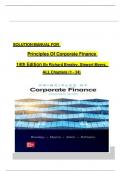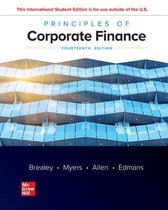e
, CHAPTER 1 e
Introduction to Corporate Finance e e e
The values shown in the solutions may be rounded for display purposes. However, the answers were
e e e e e e e e e e e e e e e
derived using a spreadsheet without any intermediate rounding.
e e e e e e e e
Answers to Problem Sets e e e
1. a. real e
b. executive airplanes e e
c. brand names e e
d. financial e
e. bonds e
*f. investment or capital expenditure e e e e
*g. capital budgeting or investment e e e
h.
e financing e
*Note that f and g are interchangeable in the question.
e e e e e e e e e e
Est time: 01-05
e e
2. A trademark, a factory, undeveloped land, and your work force (c, d, e, and g) are all real
e e e e e e e e e e e e e e e e e
assets. Real assets are identifiable as items with intrinsic value. The others in the list are
e e e e e e e e e e e e e e e e
financial assets, that is, these assets derive value because of a contractual claim.
e e e e e e e e e e e e e e
Est time: 01-05
e e
3. a. Financial assets, such as stocks or bank loans, are claims held by investors.
e e e e e e e e e e e e
Corporations sell financial assets to raise the cash to invest in real assets such as
e e e e e e e e e e e e e e e
plant and equipment. Some real assets are intangible.
e e e e e e e e e
b. Capital expenditure means investment in real assets. Financing means raising the
e e e e e e e e e e
cash for this investment.
e e e e e
c. The shares of public corporations are traded on stock exchanges and can be
e e e e e e e e e e e e
purchasedby a wide range of investors. The shares of closely held corporations are
e e e e e e e e e e e e e e
not publicly traded and are held by a small group of private investors.
e e e e e e e e e e e e e e
d. Unlimited liability: Investors are responsible for all the firm‘s debts. A sole proprietor
e e e e e e e e e e e e
has unlimited liability. Investors in corporations have limited liability. They can lose
e e e e e e e e e e e e
their investment, but no more.
e e e e e e
Est time: 01-05
e e
e
, 4. Items c and d apply to corporations. Because corporations have perpetual life, ownership can
e e e e e e e e e e e e e
be transferred without affecting operations, and managers can be fired with no effect on
e e e e e e e e e e e e e e
ownership. Other forms of business may have unlimited liability and limited life.
e e e e e e e e e e e e e
Est time: 01-05
e e
5. Separation of ownership facilitates the key attributes of a corporation, including limited liability
e e e e e e e e e e e e
for investors, transferability of ownership, a separate legal personality of the corporation, and
e e e e e e e e e e e e e
delegated centralized management. These four attributes provide substantial benefit for
e e e e e e e e e e
investors, including the ability to diversify their investment among many uncorrelated returns—a
e e e e e e e e e e e e
very valuable tool explored in later chapters. Also, these attributes allow investors to quickly
e e e e e e e e e e e e e e
exit, enter, or short sell an investment, thereby generating an active liquid market for
e e e e e e e e e e e e e e
corporations.
e e
However, these positive aspects also introduce substantial negative externalities as well. The
e e e e e e e e e e e
separation of ownership from management typically leads to agency problems, where
e e e e e e e e e e e
managers prefer to consume private perks or make other decisions for their private benefit—
e e e e e e e e e e e e e e
rather than maximize shareholder wealth. Shareholders tend to exercise less oversight of each
e e e e e e e e e e e e
individual investment as their diversification increases. Finally, the corporation‘s separate legal
e e e e e e e e e e e
personality makes it difficult to enforce accountability if they externalize costs onto society.
e e e e e e e e e e e e e e
Est time: 01-05
e e
6. Shareholders will only vote to maximize shareholder wealth. Shareholders can modify their
e e e e e e e e e e e
pattern of consumption through borrowing and lending, match risk preferences, and
e e e e e e e e e e e
hopefully balance their own checkbooks (or hire a qualified professional to help them with
e e e e e e e e e e e e e e
these tasks).
e e e
Est time: 01-05
e e
7. If the investment increases the firm‘s wealth, it increases the firm‘s share value. Ms.
e e e e e e e e e e e e e
Espinoza could then sell some or all these more valuable shares to provide for her
e e e e e e e e e e e e e e e
retirement income.
e e e
Est time: 01-05
e e
8. a. Assuming that the encabulator market is risky, an 8% expected return
e e e e e e e e e e
on the F&H encabulator investments may be inferior to a 4% return on
e e e e e e e e e e e e e
U.S.
e e
government securities, depending on the relative risk between the two assets.
e e e e e e e e e e e
b. Unless the financial assets are as safe as U.S. government securities, their cost of
e e e e e e e e e e e e e
capital would be higher. The CFO could consider expected returns on assets with
e e e e e e e e e e e e e
similar risk.
e e e
Est time: 06-10
e e
9. Managers would act in shareholders‘ interests because they have a legal duty to act in their
e e e e e e e e e e e e e e e
interests. Managers may also receive compensation— bonuses, stock, and option payouts with
e e e e e e e e e e e e
value tied (roughly) to firm performance. Managers may fear personal reputational damage from
e e e e e e e e e e e e e
not acting in shareholders‘ interests. And managers can be fired by the board of directors
e e e e e e e e e e e e e e e
(elected by shareholders). If managers still fail to act in shareholders‘ interests, shareholders
e e e e e e e e e e e e e
may sell their shares, lowering the stock price and potentially creating the possibility of a
e e e e e e e e e e e e e e e
e
, e takeover, which can again lead to changes in the board of directors and senior management.
e e e e e e e e e e e e e e e
Est time: 01-05
e e
e





